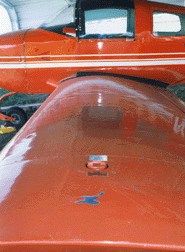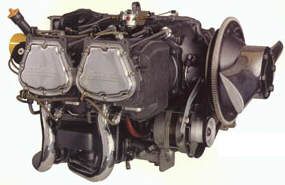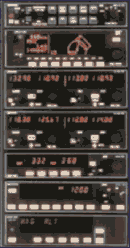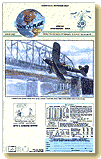 Airplane appraisals are a dimea dozen, right? There are all kinds of methods of evaluating airplanes from appraisalsoftware you can purchase, to “blue books” that supposedly give you the latestprices, to the old throw-the-dart routine. Some of those systems are useful inestablishing a range of value when a buyer is trying to decide if an airplane is worthpursuing. But a buyer — or a seller for that matter — who doesn’t take steps to know forsure what a particular airplane is worth could be on the wrong side of the financial curvewhen the deal is done. I’ve seen it happen many times.
Airplane appraisals are a dimea dozen, right? There are all kinds of methods of evaluating airplanes from appraisalsoftware you can purchase, to “blue books” that supposedly give you the latestprices, to the old throw-the-dart routine. Some of those systems are useful inestablishing a range of value when a buyer is trying to decide if an airplane is worthpursuing. But a buyer — or a seller for that matter — who doesn’t take steps to know forsure what a particular airplane is worth could be on the wrong side of the financial curvewhen the deal is done. I’ve seen it happen many times.
Airplanes are not like mass-produced automobiles. It is fairly easy to put a price tagon a used car, but airplanes require much more homework. Each plane is unique. You cantake two aircraft of the same type with consecutive serial numbers, and because ofinstalled equipment, engine times, damage history, and the type of maintenance theyreceived, there could be thousands and thousands of dollars difference in value. Mostbuyers and sellers in the used aircraft market place are not qualified to evaluate anairplane properly, and many make very poor decisions.
Ferreting out the real story
A professional airplane appraisal is more than just the value that is written on thelast page of the report. It is a comprehensive document that tells a story about theairplane being evaluated. Often the real story is one the seller doesn’t want to tell, andsometimes the buyer doesn’t want to hear.
 For example, a banker called recently and asked me toappraise a Grumman Yankee he wanted to finance for a client of his. The client was afirst-time buyer who had seen the airplane and thought it looked good. Cosmetically theairplane did look good. It would have interested anyone who was in the market forthat type. But when I studied the logbooks I didn’t like what I saw.
For example, a banker called recently and asked me toappraise a Grumman Yankee he wanted to finance for a client of his. The client was afirst-time buyer who had seen the airplane and thought it looked good. Cosmetically theairplane did look good. It would have interested anyone who was in the market forthat type. But when I studied the logbooks I didn’t like what I saw.
First, there was an entry that indicated that some damage was repaired and referred thereader to an FAA Form 337 (“Major Alteration or Repair”). However, there was noFAA Form 337 to be found in the airplane records explaining any damage or repairs to theairfram. The bank was going to do a title search on the airplane, so I asked that theirtitle search company send copies of any FAA 337 forms that were in the FAA file.
Sure enough, the damage to the airplane was recorded. The vertical stabilizer, rearfuselage bulkhead, rudder tip, beacon, windshield and canopy, nose gear torque tube, bootassembly, strut assembly, and propeller had been replaced. There was no indication as towhat happened to the airplane. It may have been turned over in a windstorm or involved ina landing accident. The dealer who owned the airplane said he had no idea that it had beendamaged at one time. He claimed he never saw the “damage repaired” entry in theairframe logbook when he bought it.
The other major problem with this airplane was that the airframe and engine had 2,056hours total time. There was no entry in the engine logbook that the Lycoming Oil PumpImpeller AD note had been complied with. (The AD requires the oil pump gears to be changedno later than 2,000 hours.) The airplane was being flown, though technically it was notairworthy because of the oil pump AD note. The dealer said he intended to take care of itsoon.
 There was a handwritten document in the airplanepaperwork that indicated that the airplane’s engine had been top overhauled about 300hours earlier, but there was nothing in the logbook. The piece of paper was not a legalsign off for the work. The engine was run out. The prospective buyer told me later that hewas under the impression that the airplane had a 2,400 hour TBO. But the pistons in theLycoming O-235 engine had not been modified, so it was still a 2,000-hour-TBO engine.
There was a handwritten document in the airplanepaperwork that indicated that the airplane’s engine had been top overhauled about 300hours earlier, but there was nothing in the logbook. The piece of paper was not a legalsign off for the work. The engine was run out. The prospective buyer told me later that hewas under the impression that the airplane had a 2,400 hour TBO. But the pistons in theLycoming O-235 engine had not been modified, so it was still a 2,000-hour-TBO engine.
When my evaluation was finished the market value of the airplane turned out to be$6,000 less than the sale price. I did not know the sale price until after I finished mywork. Both the banker and his client called to thank me for taking the time to researchthe damage and for writing a report that saved them from getting involved in an airplanewith a questionable past at what would have been too high a price.
Common valuation mistakes
It is not unusual that a good appraiser will dig up information that people don’t knowabout their own airplanes. Many aircraft owners take little interest in their airplanes,don’t know how to read the logbooks, and when they made their purchase they took the wordof the seller that nothing unusual was hidden in them. They bought the airplane like theywould have bought an automobile, after a quick test flight, without consulting anyprofessionals about the condition or value of it.
 Using the “blue book” or an on-line pricingservice may be helpful in determining a “ball park price,” but it’s a far cryfrom getting a professional appraisal. There is much that is emotional about buying andselling an airplane, and most people cannot be objective enough to go through the processthe way an appraiser (who has no interest in the airplane) would do.
Using the “blue book” or an on-line pricingservice may be helpful in determining a “ball park price,” but it’s a far cryfrom getting a professional appraisal. There is much that is emotional about buying andselling an airplane, and most people cannot be objective enough to go through the processthe way an appraiser (who has no interest in the airplane) would do.
Sellers invariably tend to overprice their airplanes because they feel they are betterthan others on the market. They look through the trade journals, find others that seemsimilar, and price theirs higher, because the one they are selling has a newer paint job,or a recent annual. Many sellers don’t understand how upgrading an airplane affects itsmarket value (generally a lot less than they think). Nor do they realize that the price ofroutine maintenance, such as an annual inspection, cannot be added to the sale price.
Occasionally I’ll appraise an airplane for a buyer, and the seller will call because hefeels I have valued the airplane too low. The first thing I ask is how he arrived at hisprice. Most of them go through the same litany of how they looked at other airplanes inTrade-A-Plane or one of the other journals, and then he will list the differences betweenhis airplane and the ones he saw in the other ads.
But when we get into the nitty gritty of his pricing effort, it turns out that not onlydid he use the “asking” prices that are in the magazines, he also added the costof a recently-completed top overhaul or the retail value of a new radio stack that he hadinstalled. (I actually had one owner tell me that he added the cost of an in-depth annualinspection that was required to make the airplane airworthy plus the cost of every gallonof avgas that he put into the airplane for the time he owned it!)
Routine maintenance that has been done does not increase the market value of anairplane, because most purchasers expect the airplanes they are buying to be airworthy.So, adding the cost of an extensive annual that was required because the airplane had beenneglected or was out of license is an exercise in self-deception. (On the other hand,required maintenance that has not been done will definitely decrease themarket value of an airplane.)
 Every new piece of equipment you install in anairplane depreciates the moment it’s installed. If you install a stack of new radios, forexample, the market value of the airplane is likely to increase by only 55 to 65 percentof what the new equipment cost (though the exact impact depends on the type of equipmentinstalled). That’s why I always recommend that buyers try to find an airplane that alreadyhas the equipment they looking for. It doesn’t hurt so much if you have to add one or twoitems, but you don’t want to take the hit for a whole installation.
Every new piece of equipment you install in anairplane depreciates the moment it’s installed. If you install a stack of new radios, forexample, the market value of the airplane is likely to increase by only 55 to 65 percentof what the new equipment cost (though the exact impact depends on the type of equipmentinstalled). That’s why I always recommend that buyers try to find an airplane that alreadyhas the equipment they looking for. It doesn’t hurt so much if you have to add one or twoitems, but you don’t want to take the hit for a whole installation.
Cosmetics can play a big role in the value of an airplane, especially when you considerhow much it costs to repaint the exterior and refurbish the interior. The industrygenerally uses the scale from 1 to 10 to describe an airplane’s appearance. The problem isthat one person’s 10 can be someone else’s 6!
While searching for a Cessna TR182 recently, I ran into a dealer who claimed hisairplane was a “9.5” on the inside and outside. He called it a “low timecream puff” in his literature. When I went to see the airplane, it was not evenclose! The cosmetics on this 1,700-hour airframe looked like it had a lot more hours thanthat, though supposedly it had been hangared its entire life. Paint on the leading edgeswas eroded, and the interior had a bedraggled look. Yet the airplane was priced far aboveother airplanes that were on the market. I passed on that one.
The importance of objectivity and experience
One difference between the professional appraiser and a buyer or seller who is tryingto put a value on an airplane is that the appraiser can be objective because he has nointerest in the airplane. A seller has his emotional bias, and a buyer wants to get thewhole thing over with so he can have an airplane to fly.
The appraiser will evaluate all aspects of the airplane, not just the paint andinterior. A large part of an appraisal is the log book search. An experienced appraisertakes his time going through the airplane records, and reads each entry. The bestairplanes have complete, detailed entries in the books, and these take time to read. Thosethat have stamped entries with no detail tell little about the history of the airplane andthe kind of maintenance it received.
The appraiser looks for many things that most pilots would not notice. For example, foreach logbook entry that refers to an FAA Form 337, the form should be present. If it isn’tit takes time to get it from the FAA. Some you can do without, but anything that involvesdamage, no matter how minor, must be investigated, especially if there is no detaileddescription of the damage in the logbooks.
Sometimes mechanics don’t make entries in the logbooks when an FAA Form 337 is filledout. If that form is lost or removed from the aircraft records, a buyer may not know aboutmajor repairs that were made to the aircraft unless he searches the FAA records for copiesof the forms that have been filed. Many pilots and aircraft owners don’t know what a 337form is, or that the FAA Aircraft Registry in Oklahoma City maintains copies of those theyreceive from local FAA offices.
Damage history and lost logs
The extent of any damage that has occurred to an airplane can directly affect itsvalue. Some types of minor damage, like complete replacement of an aileron due to hangarrash, should result in no deduction. But anything that involves structural damage willresult in diminished market value. How much of a deduction is up to the appraiser who isevaluating the airplane, and he or she will base that decision on the type of incident oraccident that occurred, the amount of damage, and the quality of the repair.
Lost logbooks can be another source of diminished value, though in most cases, theairplane’s history can be recreated and the deduction is minimal. Several years ago I hada call from a fellow who owned a Cherokee 180. The shop that had done his annualinspection lost one of his airplane’s airframe logs, and someone on the Internet told theaircraft owner that he had lost 50 percent of the aircraft’s value. Both parties agreed tohave me appraise the airplane to determine what the diminished value was. I looked at theairplane and discovered that the engine log confirmed the aircraft’s total time, and muchof its maintenance history. The owner and a mechanic who worked for the FBO attested tothe fact that the airplane had never been damaged, and there were no entries in theexisting books that indicated any type of damage. The deduction for the lost logbook wasjust under $1,700. That’s what the FBO paid the aircraft owner. A year later, while doingan annual on another airplane, the misplaced logbook was located and returned to theCherokee’s owner.
However, if all the logs are lost, as often happens when an airplane is seized by theauthorities or repossessed, and there is no way to reconstruct the aircraft’s history, thediminished value will be large. Without logs it is very difficult to determine how muchtime is on the engine(s), the total time of the airframe, and the age or time oncomponents that have a finite life. Airworthiness Directives may have to be done again,and that could be costly depending on the airplane and the nature of any AD notes thatapply.
It is impossible to put an airplane without logbooks on a Part 135 (Air Taxi)certificate unless all the components are overhauled so an accurate history of them can bestarted. The chronology of the books is important. If there are long periods with noentries, for example, an experienced appraiser will want to know why the airplane was notflown or maintained in an airworthy condition.
Often we find errors in the airframe total time or engine time that no one else haddiscovered. One seller told me the Cessna 120 he was selling had 1,800 hours on theairframe, but he was wrong. The tachometer read 1861 hours, but the logbooks indicated ithad been flown more than 4,000 hours. The owner claimed to have never looked in the books.
Establishing market value
Another very important part of the appraisal is where the benchmark pricing informationcomes from that the appraiser uses to value the airplane, and how the appraiser uses it.There are many different pricing products on the market; many of them intended for usedirectly by buyers and sellers rather than professional appraisers. It is very importantthat such products be used correctly if the resulting value is to be useful, and with someof these products the basic information and formulas that are used are questionable.
 Before you buy any aircraft pricing product for yourown use, ask the sales representative where the information comes from. If he or shedoesn’t give you a definitive answer, don’t buy it. If someone tells you that theinformation is based on “aircraft for-sale” values, don’t bother with it. Thatmeans they are just copying asking prices out of Trade-A-Plane or other trade journals,and those numbers are unrealistically high because they are asking prices, not sellingprices.
Before you buy any aircraft pricing product for yourown use, ask the sales representative where the information comes from. If he or shedoesn’t give you a definitive answer, don’t buy it. If someone tells you that theinformation is based on “aircraft for-sale” values, don’t bother with it. Thatmeans they are just copying asking prices out of Trade-A-Plane or other trade journals,and those numbers are unrealistically high because they are asking prices, not sellingprices.
Some appraisers use the Aircraft Blue Book, but most professional appraisers use theNational Aircraft Appraisers Association’s extensive aircraft database. It is just asimportant that the appraiser know and understand the product he is using. There arevarious methods of assessing the value of damage history, and each appraiser may elect toevaluate it differently.
Picking an appraiser
 The author’s 220-page book “Purchasing & Evaluating Airplanes” offers an in-depth treatment of this subject. |
If you are dealing with a bank that uses a specific appraiser, you probably have nochoice in who does the work — though it is likely that the banker has used that personbefore and is satisfied with the reports that have been received. But if you are searchingfor an appraiser yourself, ask for references and check them out. Just because someoneoffers you a business card that says he or she is an aircraft appraiser, that doesn’t makeit so. It’s possible for anyone who has access to a price digest or some type of appraisalsoftware to call themselves appraisers. But if that person does not know how to dig outthe important information about the airplane, or how to use the appraisal book or softwareproperly, you are going to pay for a report that is not accurate.
Over the years I have found forged logbooks, damage history that was not recorded,airplanes that were not registered properly or whose ownership was not clear, andcountless other problems that have a direct influence on the bottom line of the report. Ifthese problems are not fully investigated and resolved, the purchaser could wind up losinga bundle of money…or even losing the airplane!
Remember that a good aircraft appraisal is much more than the number that is at thebottom of the report. It is a vital part of any aircraft purchase.


































